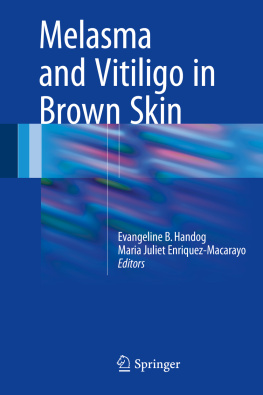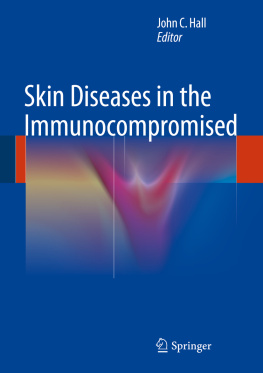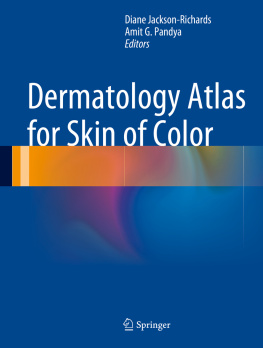Editors
Mauro Picardo and Alain Taeb
Editors
Mauro Picardo
Cutaneous Physiopathology & CIRM, San Gallicano Dermatological Institute, Rome, Italy
Alain Taeb
Hpital Saint Andr, Service de Dermatologie Adulte et Pdiatrique, INSERM U 1035, Universit de Bordeaux, Bordeaux, France
ISBN 978-3-319-62958-2 e-ISBN 978-3-319-62960-5
https://doi.org/10.1007/978-3-319-62960-5
Springer-Verlag Berlin, Heidelberg 2010 First Edition
Springer Nature Switzerland AG 2019 Second Edition
Springer Nature Switzerland AG 2019
This work is subject to copyright. All rights are reserved by the Publisher, whether the whole or part of the material is concerned, specifically the rights of translation, reprinting, reuse of illustrations, recitation, broadcasting, reproduction on microfilms or in any other physical way, and transmission or information storage and retrieval, electronic adaptation, computer software, or by similar or dissimilar methodology now known or hereafter developed.
The use of general descriptive names, registered names, trademarks, service marks, etc. in this publication does not imply, even in the absence of a specific statement, that such names are exempt from the relevant protective laws and regulations and therefore free for general use.
The publisher, the authors, and the editors are safe to assume that the advice and information in this book are believed to be true and accurate at the date of publication. Neither the publisher nor the authors or the editors give a warranty, express or implied, with respect to the material contained herein or for any errors or omissions that may have been made. The publisher remains neutral with regard to jurisdictional claims in published maps and institutional affiliations.
This Springer imprint is published by the registered company Springer Nature Switzerland AG
The registered company address is: Gewerbestrasse 11, 6330 Cham, Switzerland
Preface to the First Edition
Vitiligo has been, until recently, a rather neglected area in dermatology and medicine. Patients complain about this situation, which has offered avenues to quacks, and has led to the near orphan status of the disease. The apparently, simple and poorly symptomatic presentation of the disease has been a strong disadvantage to its study, as compared to other common chronic skin disorders such as psoriasis and atopic dermatitis. Vitiligo is still considered by doctors as a non disease, a simple aesthetic problem. A good skin-based angle of attack is also lacking because generalized vitiligo is clearly epitomizing the view of skin diseases as simple targets of a systemic unknown dysregulation (diathesis), reflecting the Hippocratic doctrine. This view has mostly restricted vitiligo to the manifestation of an auto-immune diathesis in the past 30 years. Thus, skin events, which are easily detected using skin biospies in most other situations, have not been precisely recorded, with the argument that a clinical diagnosis was sufficient for the management (or most commonly absence of management) of the patient.
This book is an international effort to summarize the information gathered about this disorder at the clinical, pathophysiological and therapeutic levels. Its primary aim is to bridge current knowledge at the clinical and investigative level, to point to the many unsolved issues, and to delineate future priorities for research. Its impetus was also to provide the best guidelines for integrated patient care, which is currently possible at a very limited number of places around the world, especially for surgical procedures.
A striking feature in the vitiligo field was, until recently, the absence of consensus on definitions, nomenclature, and outcome measures. With a group of European dermatologists, who had a strong interest in vitiligo and pigment cell research, we had launched some years ago, the Vitiligo European Task Force (VETF). The VETF has addressed those issues as a priority. This group, joined by other colleagues from the rest of the world also involved in the vitiligo research community, has communicated its experience in this book. We have tried to pilot the editing of the book according to consistent principles based on discussions held at VETF meetings and international IPCC (international pigment cell conference) workshops. However, some areas remain controversial and we have highlighted the existing conflicting issues and uncertainties.
After reviewing the field, much needs to be done. In particular, besides basic research based on the many hypotheses raised, new unbiased epidemiological, clinical, histopathological, natural history, and therapeutic data are clearly needed. They should be confronted by genetics and other investigative variables to better define the disease and its subsets. We hope that the combined efforts of all participating authors will prove useful to bring more attention to this field, and we are confident that both the research community (the mystery of melanocyte loss in vitiligo is a true scientific challenge) and the drug industry (the potential market is large) will be stimulated to bring in new treatment strategies to this large number of patients with unmet needs.
Alain Taeb
Mauro Picardo
Bordeaux, France Rome, Italy
Preface to the Second Edition
Nearly 10 years after the first edition, it was necessary to update but also to reassess the field more globally. What has changed in our vision of vitiligo in about a decade?
Developments in the field have included classification, identification of new identities, pathogenic mechanisms, investigation of normal appearing skin, and new approaches for diagnosis, treatment, and maintenance of treatment, just to mention a few. To reflect the expansion of the field, we have benefited of the expertise of a larger community of scientists and physicians, but in parallel we also tried to improve the book plan with the underlying challenging endeavor to simplify and limit redundancies.
For disease definition, clinical aspects have been better delineated, and international efforts conducted under the auspices of the Vitiligo Global Issues Consensus Conferences have simplified nomenclature and classification as well as scoring and paved the way to more uniform outcome research tools. Considering disease expression, the epidemic of vitiligoid depigmentation caused by immunotherapies has questioned the immune mechanisms of melanocyte loss in common vitiligo, a central part of disease pathophysiology.
The basic understanding of the disease for its immune/inflammatory component has undergone significant progresses and seems at work in all subsets of the disease, with immediate practical consequences but also more durable translational perspectives for therapy. Melanocyte stability, melanocyte regeneration, and epigenetics are relatively new fields in terms of basic research explored in this new edition with also important potential added value for therapy.
For therapy, our perspective has clearly changed over the last decade for segmental vitiligo which was considered previously as poorly or not at all responsive to medical treatment. Given the efficacy of early medical intervention now reported by several investigators, vitiligo of any subtype should better be considered as a therapeutic emergency to avoid irreversible immune/inflammatory losses in pigment cells. The advantage of vitiligo over type 1 diabetes is the visibility and early detection of tissue damage in most patients, allowing more reactivity. However, patients do still complain, and this has not sufficiently changed over the last decade, of the absence of interest of doctors for their disease. Patients voices are probably better heard with the more coordinated action of patients advocacies, but much more education is needed for nonspecialist and specialist physicians to use the current medical and surgical armamentarium for vitiligo. Fortunately, things should change for the availability of registered treatments, since the next decade should clearly be the era of drug development for vitiligo, following for dermatology significant progresses already accomplished for other major skin disorders such as psoriasis, atopic dermatitis, and alopecia areata.















